''This move represents a change in the way of life for local people, for police and for tourists,'' he said. ''Everything has to be explained properly, the right way. It is difficult to change a way of life. It will take time.''
In a presentation at the Royal Thai Navy base at Cape Panwa, on Phuket's east coast, Governor Nisit and senior Navy officers spelled out the changes beach by beach.
In the audience were about 40 members of Phuket's media and two coastal area mayors, the mayor of Patong, Chalermluk Kebsub, and the mayor of Cherng Talay, Ma-Ann Samran.
Governor Nisit said there were three phases to the change: the implementation of the new beach arrangements, adapting and reinforcing the arrangements, then enforcing the system.
''We are now in the second phase, adapting and trying new concepts where necessary,'' he said.
It appeared plain yesterday during the 70-minute presentation that both the governor and the Royal Thai Navy are prepared to devote time to ensuring that the clearances of public beaches, implemented after the military took charge of Thailand on May 22, do not regress.
Patong, Phuket's most popular beach, is the beach with the most swimmers and the most jet-skis.
There was no suggestion yesterday that jet-skis are to be removed from Phuket anytime soon, despite reports of scams and public opposition to the noisy, dangerous machines, which are banned in the neighboring provinces of Phang Nga and Krabi.
The governor said that it was the role of Phuket's Marine Office 5 to enforce regulations covering jet-skis.
A recent complaint has been made that jet-skis hired at neighboring beaches were now turning up at Surin beach, where jet-skis are banned.
The governor said that jet-skis hired at one beach could not be taken by the riders to another beach - something that Marine Office 5 would need to enforce.
Phuketwan believes operators and tourists have in the past often ridden jet-skis from Patong to Tri Trang beach and Freedom beach and may still be in the habit of doing so.
It is fairly natural in calm seas for tourists to want to ride jet-skis out of the bays in which they are hired. Just why jet-skis remain in favor remains unclear.
Phuket's neighboring provinces ban them and the machines were at one stage being phased out over seven years on the holiday island until Governor Nisit's predecessors compromised that promise.
Touts now offer rides to tourists along Patong beach and under the new zoning arrangements, the jet-ski business has a firm grip along the Patong shorefront.
The latest adaptation of the zoning gives swimmers five areas each of 150metres by 200 metres, interspersed with jet-ski areas along more than two kilometres of beachfront.
A confusing illustration that was supposed to show how the new arrangement worked appeared to be way out of scale and not based on reality.
If anything, the latest zonings corral the swimmers rather than the jet-skis. The machines have been given four areas along the beach, each of 300 metres.
Swimmers who chose to sit on the beach in jet-ski zones will be required to walk hundreds of meters to a safe zone. This is unlikely to happen.
Swimmers and jet-skis will continue to be in the water together - until either the swimmers or the jet-skis are banned completely.
The arrangements are to vary from beach to beach, with the 10 percent rule covering hired umbrellas - but without sunbeds - still applying.
Swimmers may bring their own umbrellas and place them where they please.
At Kata beach, the governor said, 100 umbrellas will be made available at 50 baht each.

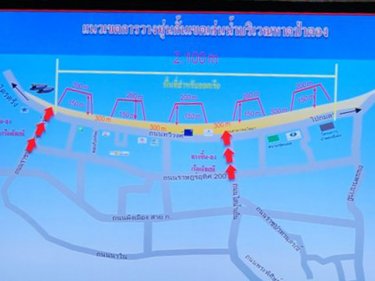
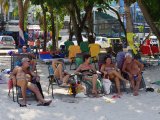
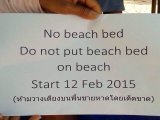

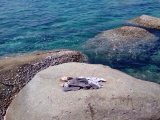




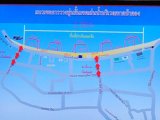



ridiculous
Posted by Peter on February 13, 2015 12:20